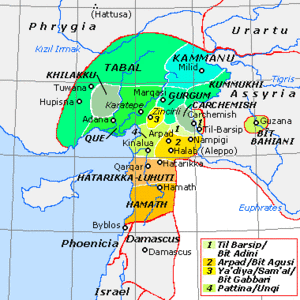Tabal (state)
Tabal Sura? | |||||||||
|---|---|---|---|---|---|---|---|---|---|
| Unknown–713 BC | |||||||||
 Tabal among the Neo-Hittite states | |||||||||
| Common languages | Hieroglyphic Luwian | ||||||||
| Religion | Luwian religion | ||||||||
| Government | Monarchy | ||||||||
| Historical era | Iron Age | ||||||||
• Established | Unknown | ||||||||
• Disestablished | 713 BC | ||||||||
| |||||||||
| Today part of | Turkey | ||||||||
Tabal (Assyrian: 𒋫𒁄) was a Luwian speaking Neo-Hittite kingdom (and/or collection of kingdoms) of South Central Anatolia during the Iron Age. According to archaeologist Kurt Bittel, references to Tabal first appeared after the collapse of the Hittite Empire.[1] Tabal was likely an exonym applied by the Assyrians to Cappadocia.[2] While its native name is uncertain, it is possible that it was called Sura, as mentioned in the records of Yariri, ruler of Carchemish.[3]
History
Originally, Tabal was likely the name of a region or collection of kingdoms. However, Tabal may have later consolidated into a single kingdom, perhaps annexing, or being annexed by, the neighboring kingdom of Melid.[4]
The Assyrian king Shalmaneser III records that he received gifts from their 24 kings in 837 BC and the following year. A century later, their king Burutash is mentioned in an inscription of king Tiglath-Pileser III. The kings of Tabal have left a number of inscriptions from the 9th-8th centuries BC in hieroglyphic-Luwian in the Turkish villages of Çalapverdi and Alişar.
During the reign of Sargon II, Tabal entered in an alliance with the Mushki and Carchemish to counter Assyria.[5]
Toward the end of the 8th century BC, Tabal was at least partially conquered by Assyria.[6]
In 640 BC, inspired by the Cimmerians, the Tabalian king Mugallu rebelled against Ashurbanipal. However, Mugallu was defeated.[7]
Ethnic composition
Some have attempted to link Tabal to the tribe of the Tibareni (Tibarenoi in Greek, Thobeles in Josephus) who lived near the Black Sea.[8][9][10] The Tibareni are mentioned in the works of Hecataeus of Miletus, Herodotus, Xenophon, Strabo, and Apollonius of Rhodes, who stated they were Scythians.[11]
The Tibareni are often viewed as Colchian, and their name may be explained as proto-Kartvelian.[12] The Georgian historian Ivane Javakhishvili (1950) considered Tabal, to be an early Kartvelian tribal designation. Cyril Toumanoff also regarded the Tabal (Tubal, Tibal, Tibar) people as proto-Georgians (Kartvelians) who would migrate with the Mushki north to the Pontic region and contribute to the formation of the Kingdom of Iberia.[13]
According to Lorenzo D'Alfonso (2012), the Tabalians may have, at least partially, descended from the Nairi tribe Tuali.[14]
List of rulers
- Tuwati I (Assyrian Tuatti), c. 837 BC[15]
- Kikki, son of Tuwati I, c. 837 BC[16]
- Tuwati II, mid 8th century BC[16]
- Wasusarma (Assyrian Wassurme), son of Tuwati II, c. 740 - 730 BC[16]
- Hulli, 730 - 726 BC[17]
- Ambaris, son of Hulli, c. 721 - 713 BC[17]
- Hidi c. 690 BC[18]
- Iškallu c. 679 BC[19]
- Mugallu/Mukalli c. 670,[18] 663, 651 BC[20]
- x-ussi, son of Mugallu[20] (ca. 650[21]/640[20] BC)
Bibliography
- Ivane Javakhishvili. Historical-Ethnological problems of Georgia, the Caucasus and the Near East. Tbilisi, 1950, pp. 130–135 (in Georgian)
- Simon Janashia. Works, vol. III. Tbilisi, 1959, pp. 2–74 (in Georgian)
- Nana Khazaradze. The Ethnopolitical entities of Eastern Asia Minor in the first half of the 1st millennium BC. Tbilisi, 1978, pp. 3–139 (in Georgian, Russian and English)
References
- ^ Kurt Bittel, Hattusha: The Kingdom of the Hittites, (New York: Oxford University Press, 1970. p.133
- ^ Lorenzo D'alfonso. "Tabal, an 'out-group' definition in the first Millennium BCE." 2012. p. 173. https://www.academia.edu/2951102/Tabal_an_out_group_definition_in_the_first_Millennium_BCE
- ^ Zsolt Simon (2012), Where is the Land of Sura of the Hieroglyphic Luwian inscription KARKAMIŠ A4b and Why Were Cappadocians Called Syrians by Greeks? Altoriental. Forsch., Akademie Verlag 39
- ^ Lorenzo D'alfonso. "Tabal, an 'out-group' definition in the first Millennium BCE." 2012. pp. 183, 186. https://www.academia.edu/2951102/Tabal_an_out_group_definition_in_the_first_Millennium_BCE
- ^ Lorenzo D'alfonso. "Tabal, an 'out-group' definition in the first Millennium BCE." 2012. p. 186. https://www.academia.edu/2951102/Tabal_an_out_group_definition_in_the_first_Millennium_BCE
- ^ Lorenzo D'alfonso. "Tabal, an 'out-group' definition in the first Millennium BCE." 2012. pp. 182-183. https://www.academia.edu/2951102/Tabal_an_out_group_definition_in_the_first_Millennium_BCE
- ^ Lorenzo D'alfonso. "Tabal, an 'out-group' definition in the first Millennium BCE." 2012. p. 183. https://www.academia.edu/2951102/Tabal_an_out_group_definition_in_the_first_Millennium_BCE
- ^ WAINWRIGHT, G. A., Tabal, Tibareni, Tabareni ( OLZ 39, 1936)
- ^ Stephen H. Rapp, Paul Crego. Languages and Cultures of Eastern Christianity: Georgian The Worlds of Eastern Christianity, 300-1500. Routledge, 2018. ISBN 1351923269, 9781351923262.
- ^ Flavius Josephus (AD 93) The Antiquities of the Jews
- ^ Lorenzo D'alfonso. "Tabal, an 'out-group' definition in the first Millennium BCE." 2012. p. 185. https://www.academia.edu/2951102/Tabal_an_out_group_definition_in_the_first_Millennium_BCE
- ^ "Journal of ancient history". 1962.
- ^ Toumanoff, Cyril (1963). Studies in Christian Caucasian History. Georgetown University Press. p. 56.
- ^ Lorenzo D'alfonso. "Tabal, an 'out-group' definition in the first Millennium BCE." 2012. p. 177. https://www.academia.edu/2951102/Tabal_an_out_group_definition_in_the_first_Millennium_BCE
- ^ Trevor Bryce: The World of the Neo-Hittite Kingdoms: A Political and Military History. Oxford, New York 2012, p. 141-145, p. 306f.
- ^ a b c Trevor Bryce: The World of the Neo-Hittite Kingdoms: A Political and Military History. Oxford, New York 2012, p. 141-145, p. 306.
- ^ a b Trevor Bryce: The World of the Neo-Hittite Kingdoms; A Political and Military History. Oxford, New York 2012, p. 141-145, p. 307.
- ^ a b Tübinger Bibelatlas / Tübingen Bible Atlas. Siegfried Mittmann, Götz Schmitt (eds.), Stuttgart: Deutsche Bibelgesellschaft, 2001, Map B IV 13.
- ^ Trevor Bryce: The World of the Neo-Hittite Kingdoms; A Political and Military History. Oxford, New York 2012, p. 293.
- ^ a b c Christian Marek, Peter Frei: Geschichte Kleinasiens in der Antike. Munich 2010, p. 802.
- ^ Ebeling, Erich; Meissner, Bruno (1990). Reallexikon der Assyriologie und Vorderasiatischen Archãologie. Germany: Walter de Gruyter & Co. p. 187. ISBN 9783110104370. Retrieved 26 October 2012.
Apart from this, the text recounts that x-ussi, the successor of Mugallu, king of Tabal...

